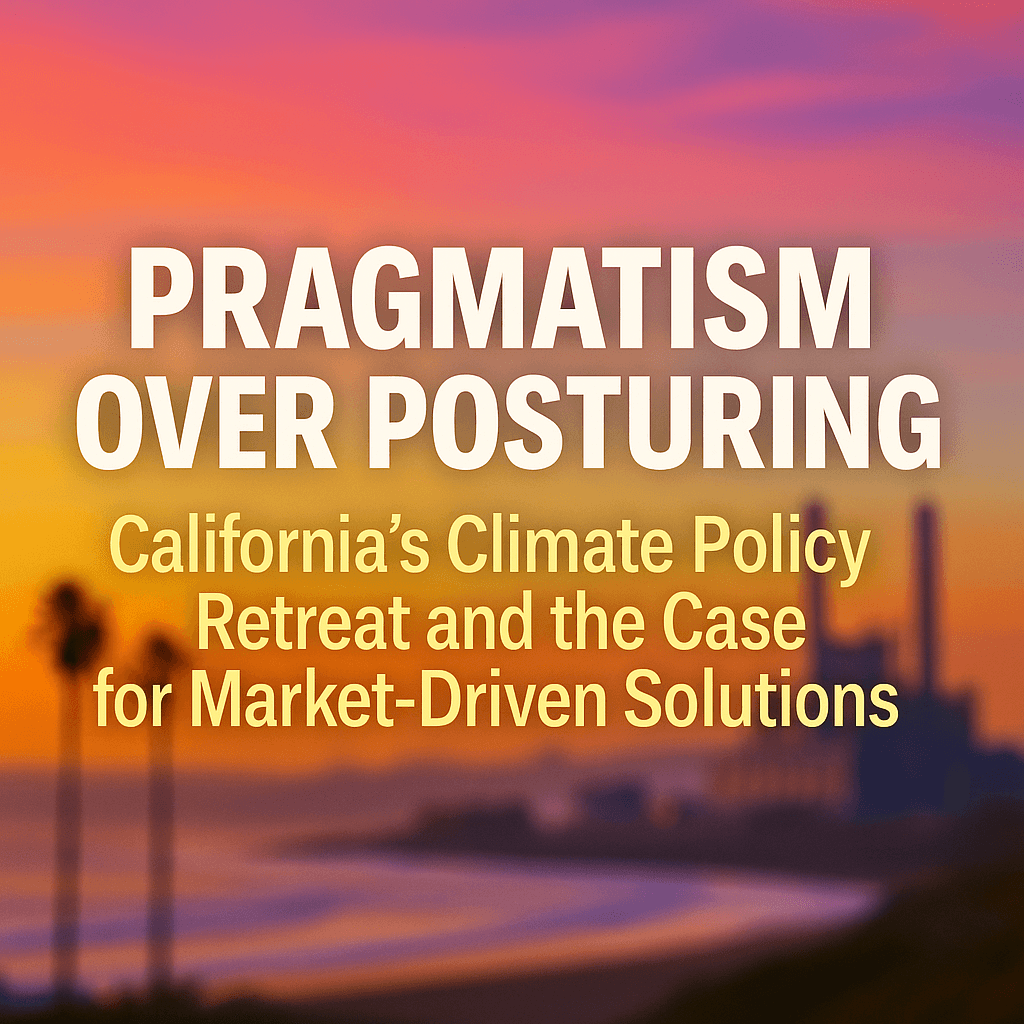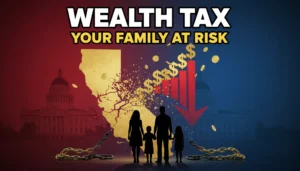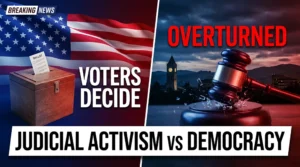Pragmatism over Posturing: California’s Climate Policy Retreat and the Case for Market-Driven Solutions

In a stunning reversal that has sent shockwaves through environmental circles, California Democrats are retreating from some of the state’s most ambitious climate policies. This shift represents more than political expediency—it signals a growing recognition that economic reality must temper ideological ambition. As California recalibrates its approach to environmental policy, conservatives have an opportunity to advance pragmatic, market-driven alternatives that balance environmental stewardship with economic prosperity.
The Democratic Retreat: Acknowledging Economic Reality
According to a recent Politico report, “In the past two weeks alone, California Democrats have retrenched on environmental reviews for construction projects, a cap on oil industry profits, and clean fuel mandates.” This remarkable shift comes after the party’s sweeping losses in the 2024 elections, which many attribute to voters’ concerns about inflation and the cost of living.
The retreat is particularly notable given California’s self-proclaimed status as a climate leader. Governor Gavin Newsom, who previously positioned himself as a champion of aggressive climate action, has now moderated his stance. His administration recently proposed steering clear of a previously announced cap on oil industry profits to prevent refinery closures—a tacit acknowledgment that ideological purity must sometimes yield to economic necessity.
“We’ve got some challenges, and so it just requires some new considerations,” Newsom told reporters, characterizing the shift not as a rollback but as “marching forward in a way that is thoughtful and considered.”
This retreat isn’t limited to California. Democratic governors in New York and Maryland are similarly pausing ambitious climate initiatives like carbon trading systems. Even in Congress, 36 Democrats—including two from California—joined Republicans in voting to overturn California’s strict vehicle emissions rules.
The Economic Case Against Climate Overreach
The economic consequences of California’s aggressive climate policies have become increasingly difficult to ignore. The state consistently ranks among the nation’s highest for energy costs, with residential electricity rates approximately 80% higher than the national average, according to the U.S. Energy Information Administration.
These high energy costs disproportionately burden low- and middle-income households. A 2024 study by the Manhattan Institute found that California households in the lowest income quintile spend approximately 21% of their after-tax income on energy costs—nearly three times the percentage spent by the highest income quintile.
“When climate policies drive up basic costs of living, they become regressive taxes on those least able to afford them,” explains Dr. Wayne Winegarden, senior fellow at the Pacific Research Institute. “California’s retreat represents a belated recognition that economic hardship undermines public support for environmental goals.”
The state’s climate policies have also contributed to a manufacturing exodus. Between 2010 and 2025, California lost over 13,000 manufacturing establishments, according to data from the National Association of Manufacturers. Companies frequently cite high energy costs and regulatory compliance burdens as factors in their decisions to relocate.
The Public Opinion Shift
This policy retreat reflects a significant shift in voter priorities. In a poll presented to Assembly Democrats during a caucus meeting, cost of living led voters’ stated priorities, while climate change ranked last. This represents a stark reversal from previous years, when climate concerns consistently ranked higher in voter surveys.
“Democrats are learning—painfully—that voters care more about immediate economic concerns than long-term climate projections,” notes political analyst Mike Madrid, co-founder of the Lincoln Project. “When families are struggling to afford gasoline, electricity, and housing, abstract environmental goals become political liabilities.”
Even in environmentally conscious California, support for climate policies declines significantly when voters are informed about their economic costs. A May 2025 Public Policy Institute of California survey found that while 68% of Californians support the state’s climate goals in principle, support drops to 42% when respondents are told these policies could increase energy costs by 15%.
The Case for Market-Driven Environmental Solutions
As California Democrats retreat from climate overreach, conservatives have an opportunity to advance market-oriented alternatives that protect both the environment and economic prosperity. Several principles should guide this approach:
1. Technology-Neutral Innovation
Rather than mandating specific technologies like electric vehicles or solar panels, policy should establish broad environmental goals and allow markets to determine the most efficient paths to achieving them. This approach encourages innovation across multiple technologies rather than picking winners and losers.
“The government’s role should be to establish clear environmental standards, not to dictate which technologies must be used to meet them,” argues James Lucier, managing director at Capital Alpha Partners. “When California mandated electric vehicles without ensuring adequate grid capacity, it created predictable problems that could have been avoided with a technology-neutral approach.”
2. Regulatory Streamlining
California’s recent move to exempt certain housing and infrastructure projects from burdensome environmental reviews represents a positive step toward regulatory rationality. This approach should be expanded to encourage energy development and manufacturing.
According to the American Action Forum, regulatory compliance costs for energy projects in California average 30% higher than in states with more streamlined processes. These costs are ultimately passed on to consumers through higher energy prices.
“Environmental protection and economic development aren’t mutually exclusive,” notes former Interior Secretary David Bernhardt. “Streamlining permitting processes while maintaining environmental standards can accelerate both clean energy deployment and economic growth.”
3. Federalism in Environmental Policy
The Trump administration’s efforts to restore state flexibility in environmental policy represent a return to proper constitutional federalism. States should have latitude to develop approaches tailored to their unique geographical, economic, and social circumstances.
“One-size-fits-all federal mandates often create inefficiencies and unintended consequences,” explains Myron Ebell, director of the Center for Energy and Environment at the Competitive Enterprise Institute. “Environmental federalism allows states to experiment with different approaches and learn from each other’s successes and failures.”
4. Cost-Benefit Analysis
All environmental regulations should be subject to rigorous cost-benefit analysis that considers both immediate economic impacts and long-term environmental benefits. This approach ensures that limited resources are directed toward policies that deliver the greatest environmental improvement at the lowest economic cost.
A 2024 study by the Mercatus Center found that when environmental regulations undergo thorough cost-benefit analysis, they typically become more targeted and effective, reducing compliance costs by an average of 15% while maintaining environmental benefits.
Real-World Success Stories
Several states have demonstrated that market-oriented approaches can deliver environmental benefits without economic harm:
Texas has led the nation in wind energy development without mandates, instead creating a competitive electricity market that allows renewable energy to compete on its merits. The state now produces more wind power than all but five countries worldwide.
Ohio implemented a regulatory streamlining initiative that reduced permitting times for energy projects by 40% while maintaining environmental standards, resulting in $5.2 billion in new energy investment between 2022 and 2025.
Florida has significantly reduced carbon emissions through natural gas adoption and nuclear power, achieving a 15% reduction in emissions since 2005 while maintaining electricity rates below the national average.
These success stories demonstrate that environmental progress and economic prosperity can be complementary rather than contradictory goals when pursued through market-oriented policies.
The Path Forward for California
As California recalibrates its approach to climate policy, several specific reforms would promote both environmental and economic goals:
- Reform cap-and-trade: Modify the state’s cap-and-trade program to include automatic price ceilings that prevent energy cost spikes during economic downturns.
- Embrace natural gas: Recognize natural gas as a transition fuel that can reduce emissions while maintaining energy affordability and reliability.
- Streamline permitting: Expand recent CEQA exemptions for housing to include energy infrastructure and manufacturing facilities that improve environmental performance.
- Technology-neutral standards: Replace technology mandates with performance standards that allow businesses and consumers to choose the most cost-effective compliance methods.
- Nuclear power: Reverse the planned closure of Diablo Canyon nuclear plant and streamline permitting for new nuclear facilities, recognizing nuclear power’s role as a reliable, zero-emission energy source.
Conclusion: Balancing Environmental and Economic Priorities
California’s climate policy retreat offers important lessons for environmental policy nationwide. When environmental ambition outpaces economic reality, the resulting backlash can undermine public support for even reasonable environmental measures.
The path forward requires balancing legitimate environmental concerns with economic prosperity through market-oriented solutions that harness innovation, reduce regulatory burdens, respect federalism, and prioritize cost-effectiveness. This approach recognizes that environmental stewardship and economic growth are complementary rather than contradictory goals.
As former California Assembly leader Chad Mayes observed regarding the state’s climate policy retreat, “If you’re going to talk about affordability then you have to be honest about the policies you’ve put in place and what those costs are.”
This honesty about tradeoffs represents the first step toward a more sustainable environmental policy—one that protects both natural resources and economic opportunity. By embracing pragmatism over posturing, California and the nation can develop environmental policies that enjoy broad public support and deliver lasting benefits for both the environment and the economy.













